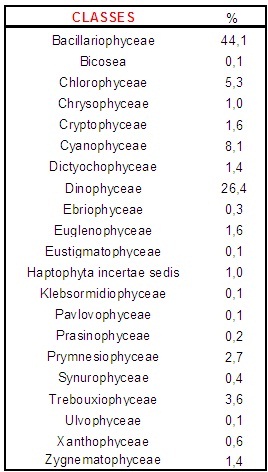ATLAS OF LAGOON PHYTOPLANKTON
One of the specific objectives of the project is the construction of an on-line atlas of reference for the recognition of taxa belonging to nano- and microphytoplankton corporations, particularly in transitional aquatic and marine-coastal environments in the Mediterranean and Atlantic ecoregions.
Currently the atlas contains 1050 records, divided into phytoplankton classes as in Figure 1:
Each record includes:
- The association of each taxon with a geometric shape, essential for the calculation of its surface area and biovolume. In this regard, several authors have proposed a set of geometric shapes associated with the main genres of phytoplankton (Kovala and Larrance, 1966; Edler, 1979; Rott, 1981; Hillebrand et al., 1989; Sun and Liu, 2003, Vadrucci et al., 2007). Each record in the Atlas shows the geometry and the linear dimensions of each taxon, necessary for calculating the surface area (μm2) and biovolume (μm3);
- A gallery of images to facilitate identification, since a morphological description alone can sometimes be insufficient. The gallery is created using photographs of the nano- and microphytoplankton guilds observed by inverted optical microscope in bright field or phase contrast. Images generated in this way correspond to the operator’s view during routine analysis. For each taxon multiple images are included; some reproduce the entire cell in different views (dorsal, ventral), others show small details or distinctive characteristics, i.e. those elements that are required for determination in the consultation phase;
- Synonyms, if present;
- A description of the morphological characteristics, for recognition of species and other taxa. Each record contains a description of the morphology of the taxon, and for some terms there is a glossary, very useful for non-experts. In addition to the explanation of the term, simple drawings and diagrams are included where possible;
- Information on the geographical distribution as a distinctive trait that is important for identification. Direct links show the geographical distribution of each taxon;
- Bibliographical references enabling the user to learn more.

Bibliographical references
- Edler,.L. 1979. Recommendations on methods for Marine Biological Studies in the Baltic sea:phytoplankton and Chlorophyll. Baltic Marine Biological pubblication. N°5: 38 pp.
- Hillebrand, H. C.D., Durselen, D., Kirschtel, U. Pollingher, T., Zohary, T.1989. Biovolume calculation for pelagic and benthic microalgae. Journal of Phycology 35: 403-424.
- Kovala P. E., Larrance J. P. (1966). Computation of phytoplankton cell number, cell volume, cell surface area and plasma volume per litre, from microscopical counts. University of Washington. Special report vol. 38: 1-91.
- Rott, E. 1981. Some results from phytoplankton counting intercalibrations. Schweiz. Z. Hydrobiology 43: 34-62.
- Sun, J. and Liu, D. 2003. Geometric models for calculating cell biovolume and surface area for phytoplankton. Journal of Plankton Research. 25(11): 1331-1346
- Vadrucci M. R., Cabrini M., Basset A. (2007). A biovolume determination of phytoplankton guilds in transitional water ecosystems of Mediterranean Ecoregion. Transitional Water Bullettin Vol 1(2): 83-102.
Please log-in to join the “Atlas of Lagoon Phytoplankton”